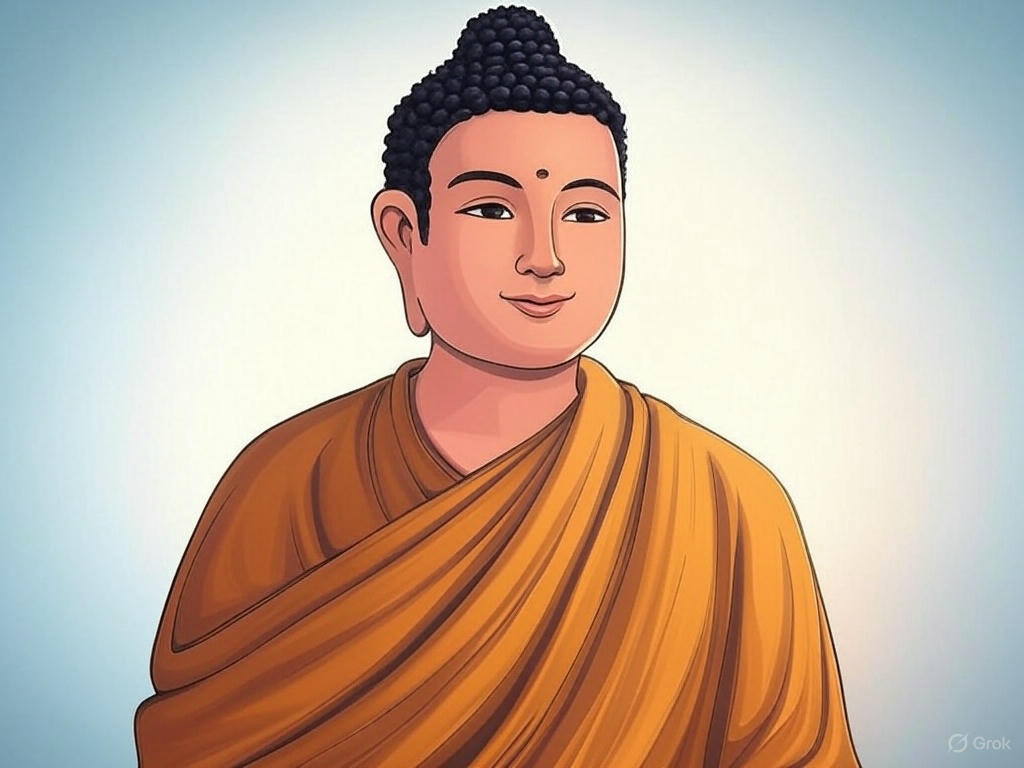Buddha's Daily Habits for Enlightenment and Wellbeing
The Buddha's Path to a Balanced Life
Siddhartha Gautama, the Buddha, exemplified a life of moderation, mindfulness, and compassion through his daily habits. These practices, born from his journey to enlightenment, offer a timeless blueprint for cultivating inner peace and well-being.
From mindful eating and walking meditation to deeper practices like death contemplation and loving-kindness radiation, the Buddha's habits emphasize balance and awareness in every aspect of life.
- Emphasis on mindfulness in daily activities
- Cultivation of compassion and humility
- Pursuit of balance and moderation
- Integration of spiritual practice with daily life
- Focus on inner peace and wellbeing
Discover how embracing these ancient habits can bring greater clarity, compassion, and balance into your modern life.
Filter Habits
 Buddha Siddhartha Gautama's Habit Sets
Buddha Siddhartha Gautama's Habit Sets
Middle Path Moderation
Avoiding extremes of indulgence or deprivation in all aspects of life. Promotes sustainable physical health and mental clarity through balanced nutrition, exercise, and spiritual practice.
Why This Matters
Siddhartha Gautama adopted this principle after experiencing both luxury and extreme asceticism. It became foundational to his teachings as a practical path to enlightenment.

Walking Meditation
Practicing mindfulness during slow, deliberate walks by focusing on bodily sensations and breath. Enhances awareness while integrating movement with spiritual practice.
Why This Matters
The Buddha used this method to teach mindfulness in daily activities. It balanced physical exercise with meditative focus during long teaching journeys.

Four-Hour Sleep Cycle
Sleeping minimally from 2-4 AM after nighttime meditation. Maintains alertness for teaching while demonstrating mastery over bodily needs.
Why This Matters
The Buddha prioritized spiritual duties over physical comfort, using early waking hours for compassionate service and deep contemplation.

Alms Round Practice
Begging for daily meals without discrimination between donors. Cultivates humility and dependence on community while teaching non-attachment.
Why This Matters
Siddhartha Gautama ate whatever was offered to demonstrate equality and break caste-based food taboos. This habit embodied his Middle Way philosophy.

Dawn Mental Survey
Scanning the world each morning with meditative awareness to identify beings needing help. Develops universal compassion and proactive teaching approach.
Why This Matters
The Buddha used this practice to focus his daily teachings on those most receptive, embodying his vow to relieve suffering for all sentient beings.

Post-Meal Rest Period
Sitting quietly after midday meal for digestion and mental preparation. Maintains energy for afternoon teachings while modeling mindful consumption.
Why This Matters
Siddhartha Gautama recognized the connection between physical health and teaching effectiveness, using rest to integrate nourishment and Dharma.

Nighttime Deva Dialogues
Engaging celestial beings in Dharma discussions during late hours. Demonstrated teaching adaptability across perceived realms of existence.
Why This Matters
The Buddha used these encounters to show the universal applicability of his teachings, while addressing subtle existential questions from advanced practitioners.

Single-Task Focus
Completing each activity with full attention before starting another. Enhances presence and reduces mental clutter during teaching activities.
Why This Matters
Siddhartha Gautama modeled complete engagement whether eating, walking, or teaching - demonstrating that enlightenment permeates all actions.

Rainy Season Retreats
Staying in one location during monsoons for intensive practice. Protected wandering monks while enabling deep study during agriculturally sensitive period.
Why This Matters
The Buddha adapted his peripatetic lifestyle to environmental conditions, showing respect for lay communities' crops and need for concentrated practice.

Mindful Eating Protocol
Chewing food thoroughly while contemplating its origins. Transforms eating into meditation on interdependence and gratitude.
Why This Matters
The Buddha used meals as teaching moments about impermanence - noting how consumed food becomes both body and teaching energy.

Teaching Through Questions
Addressing individual doubts before group discourses. Personalized Dharma transmission while modeling patient listening.
Why This Matters
Siddhartha Gautama adapted teachings to listeners' capacities, using inquiry to reveal their innate wisdom rather than imposing doctrines.

Forest Solitude Periods
Regular withdrawal into wilderness for undistracted practice. Maintained connection with ascetic roots while demonstrating self-reliance.
Why This Matters
The Buddha balanced teaching obligations with personal retreats, showing that enlightenment requires both community engagement and solitary reflection.

Mara Confrontation Ritual
Consciously facing inner demons through meditative equipoise. Demonstrated mastery over fear and temptation through non-reactive awareness.
Why This Matters
Siddhartha Gautama used these psychological encounters as teaching tools about the nature of illusion and liberation from mental bondage.

Mudra Communication
Using symbolic hand gestures during teachings. Conveyed complex concepts non-verbally to diverse audiences.
Why This Matters
The Buddha supplemented verbal teachings with physical expressions to reach disciples at different developmental stages, embodying skillful means.

Seasonal Robe Change
Adjusting clothing weight with temperature shifts. Demonstrated adaptability and respect for physical needs without luxury.
Why This Matters
Siddhartha Gautama modeled practical asceticism - using robes only for protection from elements, not for status or decoration.

Bodhi Tree Reconnection
Periodic return to enlightenment site for renewal. Maintained connection with awakening experience while inspiring disciples.
Why This Matters
The Buddha used physical location as teaching metaphor, showing that enlightenment isn't confined to places but remembered through practice.
Death Contemplation
Regular meditation on mortality and impermanence. Cultivated urgency in practice and appreciation for precious human life.
Why This Matters
Siddhartha Gautama used maraṇasati (death awareness) to maintain his own enlightenment motivation and that of his disciples.

Interdependent Origination
Analyzing phenomena through cause-effect relationships. Developed insight into emptiness while teaching logical examination.
Why This Matters
The Buddha used this framework to help disciples break attachment cycles, grounded in his own enlightenment experience under the Bodhi tree.

Loving-Kindness Radiation
Systematically extending goodwill to all beings. Dissolved barriers between teacher and student while modeling universal compassion.
Why This Matters
Siddhartha Gautama used metta practice to maintain equanimity amid constant demands, demonstrating that enlightenment includes emotional mastery.

Dharma Jewel Remembrance
Daily recollection of Buddha, Dharma, and Sangha. Reinforced teaching authority while preventing personality cult development.
Why This Matters
The Buddha focused disciples on principles rather than himself, using this practice to decentralize spiritual authority after his parinirvana.
Key Takeaways from the Buddha's Daily Routine
The Buddha's daily habits offer profound insights into living a more mindful and purposeful life.
- Mindfulness is Key: The Buddha integrated mindfulness into every activity, from walking to eating, emphasizing present moment awareness.
- Balance is Essential: The Middle Path highlights the importance of avoiding extremes and finding balance in all aspects of life.
- Compassion in Action: Practices like the Dawn Mental Survey and Loving-Kindness Radiation underscore the significance of cultivating universal compassion.
- Spiritual Practice as Foundation: Habits like meditation and Dharma Jewel Remembrance demonstrate the importance of consistent spiritual practice for inner growth.
- Simplicity and Humility: The Alms Round Practice and Seasonal Robe Change highlight the value of humility and detachment from material possessions.
Incorporate these timeless principles into your daily life and embark on your own path towards greater well-being and inner peace.
